Grade 5 money math worksheets: Word problems with solutions
Hi there! Are you ready to ace your 5th grader's money skills? Worry less! This article provides fun and engaging Grade 5 money math worksheets and exciting word problems with solutions. Also, in this article, you will find the simplest ways to explain:
-
- How to master money word problems in 5 easy steps!
- Fun and engaging 5th-grade worksheets to practice money skills
- Adding and subtracting money word problems
- Multiplying and dividing money word problems
- How to calculate sales tax and discounts
- Tips and tricks to solve any money word problem
- Real-life examples of money word problems and how to solve them
- Bonus: additional grade 5 money math worksheets to boost 5th graders' confidence and knowledge
- Conclusion: applying money math skills to real-life situations
Grade 5 money math worksheets: The ultimate guide to saving and spending
Help your 5th graders find an ultimate guide to saving and spending with the help of these fantastic Grade 5 money math worksheets from selected Mathskills4kids.com.
These engaging 5th-grade money worksheets from Mathskills4kids consist of simple exercises for practicing money skills, such as adding and subtracting money, multiplying and dividing money, calculating sales tax and discounts, and more.
In this article, we'll also show 5th graders how to solve money word problems in 5 easy steps. Plus, we'll share some tips and tricks to solve any money word problem and real-life examples of money word problems.
And as a bonus, we'll give you access to some additional grade 5 money math worksheets that will take your 5th grader's money math skills to the next level!
Ready to get started? Let's dive in!
-
BROWSE THE WEBSITE
-
DOWNLOAD FREE WORKSHEETS
-
-
5th GRADE MATH TOPICS
- Number sense
- Addition and subtraction
- Multiplication
- Division
- Exponents
- Number theory
- Decimals
- Add & subtract decimals
- Multiply decimals
- Divide decimals
- Fractions & mixed numbers
- Add & subtract fractions
- Multiply fractions
- Divide fractions
- Mixed operations
- Problems solving
- Ratios and rates
- Percentages
- Money Math
- Number sequences
- Coordinate graph
- Variable expressions
- Data and Graphs
- Probability and statistics
- Telling time
- Unit of measurements
- 2D figures
- Triangles & quadrilaterals
- Symmetry & transformations
- 3D figures
- Geometric measurements
-
-
Adding and subtracting money amounts word problems
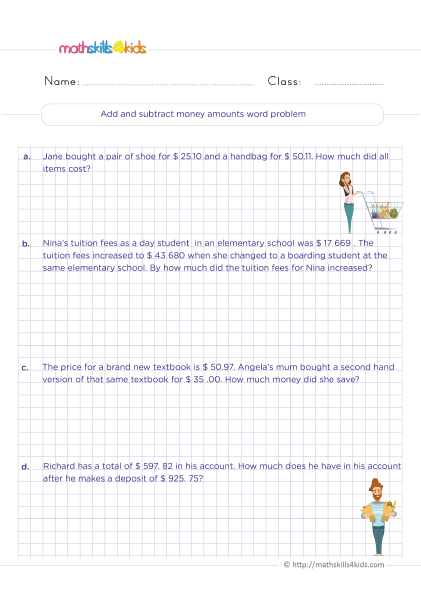 Print it...
Print it...
-
How to solve multiplication money amounts word problems?
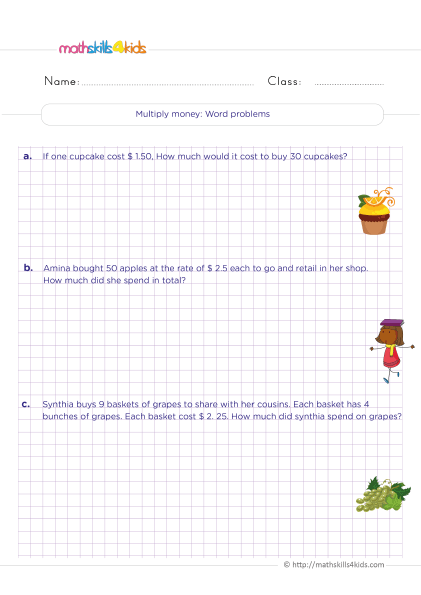 Print it...
Print it...
-
Multiplying money word problems with solution and answers
 Print it...
Print it...
-
Dividing money word problems with solution and answers
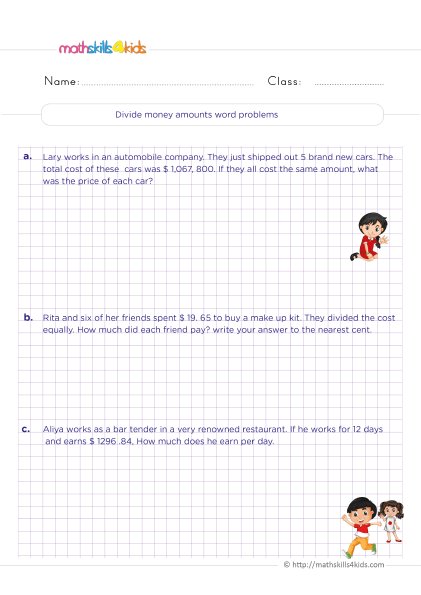 Print it...
Print it...
-
Price lists
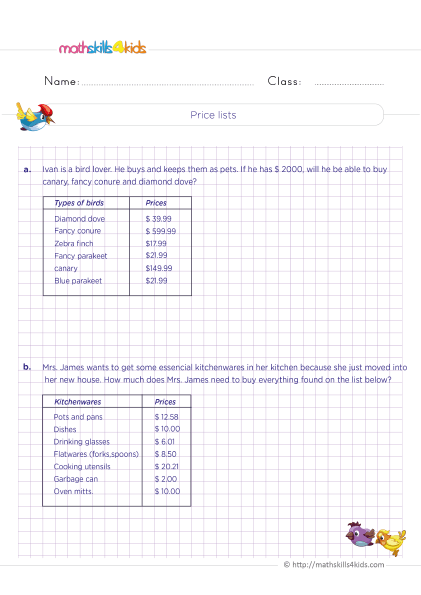 Print it...
Print it...
-
cost price and selling price with solution and answers
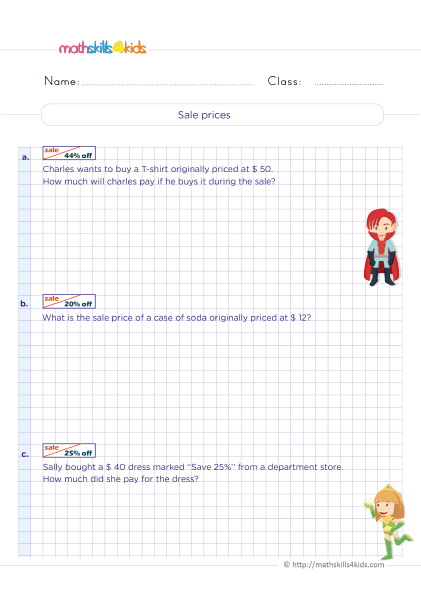 Print it...
Print it...
-
Adding and subtracting money amounts word problems
-
Buying is supporting us!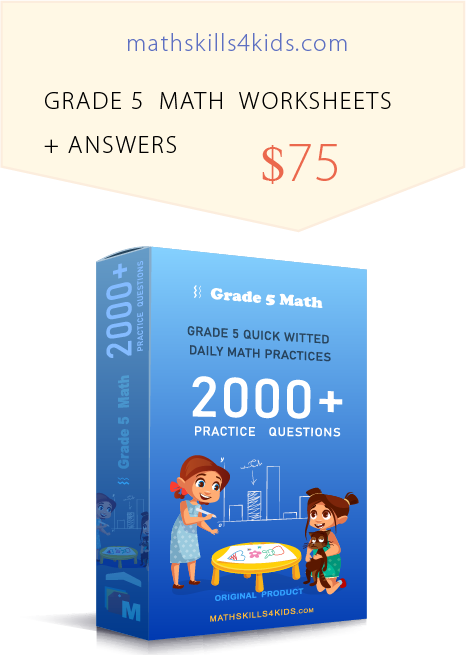
Buy Now...
-
-
How to master money word problems in 5 easy steps!
Money word problems can be tricky but don't have to be. Here are 5 easy steps that will help 5th graders to master money word problems solving skills in no time:
- Read the problem carefully and identify what is given and what is asked. Look for keywords that indicate the operation needed, such as "total," "change," "spent," "earned," "saved," etc.
- Write down the given information using the same units of money (dollars or cents). If necessary, convert between units using the rule that 100 cents = 1 dollar.
- Choose the appropriate operation (addition, subtraction, multiplication, or division) and set up an equation using variables or symbols to represent the unknown quantities.
- Solve the equation using the order of operations (PEMDAS) and check your answer by plugging it back into the equation.
- Write your answer in a complete sentence using the correct units of money and label it clearly.
That's it! Following these 5 steps, your 5th grader can confidently and accurately solve any money word problem.
-
Fun and engaging Grade 5 money math worksheets to practice money skills
Now that you know how to solve money word problems, it's time to practice! We've selected some fun and engaging grade 5 money math worksheets from Mathskills4kids.com that cover various money skills, such as:
- Adding and subtracting money word problems: These worksheets will help your 5th grader practice adding and subtracting money amounts with decimals and finding the change from a given amount.
- Multiplying and dividing money word problems: These worksheets will help your 5th grader practice multiplying and dividing money amounts by whole numbers or decimals and finding the unit price or rate of a given item or service.
- How to calculate sales tax and discounts: These worksheets will help your 5th grader practice calculating sales tax and discounts on purchases and finding the final price or cost of an item or service after applying the tax or discount.
- Real-life examples of money word problems and how to solve them: These worksheets will present your 5th grader with some realistic scenarios of money word problems that they may encounter in their daily lives, such as shopping, budgeting, saving, investing, etc.
-
Adding and subtracting money word problems
Let's start with adding and subtracting money word problems. These are problems where you will find the total amount of money or the change after buying something. For example, how much money do you spend buying a book for $12.50 and a pencil for $0.75? Or, if you have $20 and buy a sandwich for $4.25, how much money do you have left?
To solve these problems, you must line up the decimal points and add or subtract the numbers as usual. Remember to put the dollar sign and the decimal point in your answer!
-
Multiplying and dividing money word problems worksheet
Next, we have multiplying and dividing money word problems. These are problems where you will find the product or the quotient of money and a number. For example, if you earn $8 per hour and work 5 hours, how much money do you earn? Or, if you have $50 and want to split it equally among 4 friends, how much money does each friend get?
To solve these problems, you will multiply or divide the numbers as usual, but be careful with the decimal point. Move it two places to the left when multiplying and two places to the right when dividing. Also, remember to put the dollar sign and the decimal point in your answer!
-
How to calculate sales tax and discounts
Another important topic is how to calculate sales tax and discounts. Sales tax is a percentage of the price you must pay extra when buying something. For example, how much do you have to pay if you buy a shirt for $15 and the sales tax is 10%?
To find the sales tax amount, multiply the price by the sales tax rate as a decimal (10% = 0.1). Then, add the sales tax amount to the original price to get the total price. In this case, the sales tax amount is $15 x 0.1 = $1.5, and the total price is $15 + $1.5 = $16.5.
Discounts are a percentage of the price you save when buying something on sale. For example, how much do you pay if you buy a pair of shoes for $40 and the discount is 25%?
To find the discount amount, multiply the original price by the discount rate as a decimal (25% = 0.25). Then, subtract the discount amount from the original price to get the sale price. In this case, the discount amount is $40 x 0.25 = $10, and the sale price is $40 - $10 = $30.
-
10 real-life examples of 5th Grade money word problems with solutions
Finally, let's look at some real-life examples of 5th Grade money word problems with solutions. These are problems that involve more than one step or operation, requiring careful reading and thinking. For example;
If you go to a movie theater with your friend and buy two tickets for $8 each, a large popcorn for $6, and two drinks for $3 each, how much money do you spend? To solve this problem, add all the costs: 2 x $8 + $6 + 2 x $3 = $28.
Or, if you have a coupon that gives you 20% off on any item at a store, and you buy a jacket that costs $45 before tax, and the sales tax is 8%, how much do you pay? To solve this problem, first find the sale price after applying the coupon: $45 - ($45 x 0.2) = $36. Then, find the sales tax amount: $36 x 0.08 = $2.88. Finally, add the sale price and the sales tax amount: $36 + $2.88 = $38.88.
Real-life situations-money math problems with solutions
- Anna wants to buy a new bike that costs $250. She has saved $120 so far, and she earns $10 every week for doing chores. How many more weeks does she need to save to buy the bike?
Solution: To solve this problem, find out how much more money Anna needs to buy the bike and then divide that by her weekly income. We can use subtraction and division to do this.
$250 - $120 = $130
$130 / $10 = 13
Anna needs 13 more weeks to save enough money for the bike.
- Ben has a lemonade stand. He sells each cup of lemonade for 50 cents. He spends 20 cents on each cup for the ingredients. How much profit does he make for each cup of lemonade he sells?
Solution: To solve this problem, we need to find out how much money Ben earns and how much he spends for each cup of lemonade, then subtract the cost from the revenue. We can use multiplication and subtraction to do this.
$0.50 x 1 = $0.50 (revenue)
$0.20 x 1 = $0.20 (cost)
$0.50 - $0.20 = $0.30 (profit)
Ben makes 30 cents of profit for each cup of lemonade he sells.
- Charlie has a piggy bank with $15 in it. He wants to buy a video game that costs $60. His parents agree to pay half of the price if he pays the other half. How much more money does Charlie need to save to buy the video game?
Solution: To solve this problem, we need to find out how much money Charlie's parents will pay and how much Charlie has to pay, and then subtract what he already has from what he needs. We can use division and subtraction to do this.
$60 / 2 = $30 (Charlie's parents' share)
$60 / 2 = $30 (Charlie's share)
$30 - $15 = $15
Charlie needs $15 more to buy the video game.
- Dani has a coupon that gives her 20% off any item at the bookstore. She wants to buy a book that costs $12. How much will she pay for the book after using the coupon?
Solution: To solve this problem, we need to find out how much money Dani will save with the coupon and how much she will pay after applying the discount. We can use multiplication and subtraction to do this.
$12 x 0.20 = $2.40 (discount amount)
$12 - $2.40 = $9.60 (final price)
Dani will pay $9.60 for the book after using the coupon.
- Ella wants to buy a necklace that costs $18. She has three bills in her wallet: a $10 bill, a $5 bill, and a $1 bill. How much change will she get back if she pays with these bills?
To solve this problem, we need to find out how much Ella has in total and how much she will spend on the necklace, then subtract the price from the amount. We can use addition and subtraction to do this.
$10 + $5 + $1 = $16 (total amount)
$18 - $16 = $2 (change amount)
Ella will get back $2 in change if she pays with these bills.
- Frank has a jar of coins. He has 12 quarters, 15 dimes, 18 nickels, and 20 pennies in it. How much money does he have in total?
To solve this problem, we will determine how much each type of coin is worth and add up the total. We can use multiplication and addition to do this.
$0.25 x 12 = $3 (quarters)
$0.10 x 15 = $1.50 (dimes)
$0.05 x 18 = $0.90 (nickels)
$0.01 x 20 = $0.20 (pennies)
$3 + $1.50 + $0.90 + $0.20 = $5.60 (total amount)
Frank has $5.60 in his jar of coins.
- Grace wants to split a pizza with her two friends, Hannah and Isla. The pizza costs $12 and has 8 slices. How much should each person pay if they share the pizza equally?
To solve this problem, we need to find out how many slices each person gets and how much each slice costs, then multiply the cost by the number of slices. We can use division and multiplication to do this.
8 / 3 = 2.67 (slices per person)
$12 / 8 = $1.50 (cost per slice)
$1.50 x 2.67 = $4.01 (cost per person)
Each person should pay $4.01 if they share the pizza equally.
- Jack has a paper route. He delivers 40 newspapers daily and gets paid $0.25 for each. He also gets a $5 bonus every week. How much money does he make in a month (30 days)?
To solve this problem, we need to determine how much money Jack makes per day, week, and month and then add the amounts. We can use multiplication and addition to do this.
$0.25 x 40 = $10 (daily income)
$10 x 7 = $70 (weekly income)
$70 + $5 = $75 (weekly income with bonus)
$75 x 4 = $300 (monthly income)
Jack makes $300 a month.
- Kelly wants to buy a pair of jeans that costs $40. She has a coupon that gives her 15% off any item at the clothing store. She will also pay an 8% sales tax on the final price. How much will she pay for the jeans after using the coupon and paying the tax?
Solution: To solve this problem, we need to find out how much money Kelly will save with the coupon, how much she will pay before tax, and how much tax she will pay, and then add up the amounts. We can use multiplication and addition to do this.
$40 x 0.15 = $6 (discount amount)
$40 - $6 = $34 (price before tax)
$34 x 0.08 = $2.72 (tax amount)
$34 + $2.72 = $36.72 (final price)
Kelly will pay $36.72 for the jeans after using the coupon and paying the tax.
- Leo has a budget of $100 for his birthday party. He wants to invite 10 friends and buy them pizza, cake, ice cream, and drinks. He estimates that each pizza will cost $12, each cake will cost $15, each gallon of ice cream will cost $6, and each liter of soda will cost $2. How many pizzas, cakes, ice creams, and sodas can he buy without going over his budget?
Solution: To solve this problem, we need to find out how much money Leo will spend on each item and how many items he can buy with his budget, then compare the amounts. We can use multiplication and division to do this.
$12 x 1 = $12 (one pizza)
$15 x 1 = $15 (one cake)
$6 x 1 = $6 (one gallon of ice cream)
$2 x 1 = $2 (one liter of soda)
$100 / $12 = 8.33 (maximum number of pizzas)
$100 / $15 = 6.67 (maximum number of cakes)
$100 / $6 = 16.67 (maximum number of ice creams)
$100 / $2 = 50 (maximum number of sodas)
One possible solution is to buy 8 pizzas, 1 cake, 2 gallons of ice cream, and 10 liters of soda.
$12 x 8 = $96 (cost of pizzas)
$15 x 1 = $15 (cost of cake)
$6 x 2 = $12 (cost of ice cream)
$2 x 10 = $20 (cost of soda)
$96 + $15 + $12 + $20 = $143 (total cost)
However, this solution exceeds Leo's budget by $43, so he needs to reduce some items or find cheaper alternatives.
Another possible solution is to buy 6 pizzas, 1 cake, 1 gallon of ice cream, and 12 liters of soda.
$12 x 6 = $72 (cost of pizzas)
$15 x 1 = $15 (cost of cake)
$6 x 1 = $6 (cost of ice cream)
$2 x 12 = $24 (cost of soda)
$72 + $15 + $6 + $24 = $117 (total cost)
This solution is within Leo's budget by $17, so he can either save the money or buy more items if he wants.
There may also be other possible solutions, as long as they are within Leo's budget.
These money math questions are fun, engaging, and challenging. They will help you develop 5th graders’ math, critical thinking, and financial literacy skills.
- Anna wants to buy a new bike that costs $250. She has saved $120 so far, and she earns $10 every week for doing chores. How many more weeks does she need to save to buy the bike?
Bonus: Additional money math resources to boost 5th graders' confidence and knowledge
If you want to give your 5th grader some extra practice and challenge in money math skills, we can advise you with some excellent websites, games, videos, and worksheets that you can use to supplement your money math lessons.
These resources cover decimals, fractions, percentages, interest, taxes, budgeting, etc. Check them out and see how they can boost your 5th graders' confidence and knowledge in money math!
- Math Playground: This website has tons of interactive games and activities that teach and practice money math skills. You can find games for different grade levels and topics, such as Decimal Place Value Pirates, Fraction Matcher, Percent Shopping, and Money Word Problems. Your students will love playing these games and learning at the same time! Visit https://www.mathplayground.com/ASB_Dolphin_Dash.html to explore the games.
- co Academy: This website is a great resource for learning and reviewing money math concepts. You can watch videos to teach your 5th-grade students how to do addition and subtraction with various money amounts. You can also teach them to solve word problems and calculate the merchandise's unit price. Visit https://study.com/academy/topic/5th-grade-math-money.html and teach money math in an exciting way.
- Math is Fun: This website has a lot of helpful information and examples that help you understand money math topics. You can read about the basics of money, such as coins, bills, currency, exchange rates, and rounding. You can also learn about more advanced topics, such as decimals, fractions, percentages, interest, taxes, budgeting, and saving. Visit https://www.mathsisfun.com/money/index.html to browse the topics.
- BrainPOP: This website has engaging videos and quizzes that teach you about money math topics. You can watch videos that feature Tim and Moby, two funny characters who explain the topics in a fun and easy way. You can also take quizzes that test your knowledge and give you feedback. Visit https://www.brainpop.com/games/moneymagic/ to watch the video on money.
-
-
Thank you for sharing the links of MathSkills4Kids.com with your loved ones. Your choice is greatly appreciated.
Conclusion: applying money math skills to real-life situations
Money math skills are essential for 5th graders to learn and master, as they will help them become financially literate and responsible in the future. By practicing money word problems and other money math skills using Mathskills4kids’ worksheets, your 5th grader will be able to apply their knowledge and skills to real-life situations, such as:
- Planning and managing their finances, such as saving, spending, budgeting, investing, etc.
- Making intelligent and informed shopping decisions, such as comparing prices, finding the best deals, calculating taxes and discounts, etc.
- Understanding and using different forms of money, such as cash, checks, debit cards, credit cards, etc.
- Developing a positive attitude towards money and its value, such as appreciating what they have, being generous and charitable, avoiding debt and fraud, etc.
We hope you enjoyed this article and found it helpful. We encourage you to use our worksheets to help your 5th grader master money word problems and other money math skills.
We invite you to visit mathskills4kids.com for more enriching math worksheets in all Grades. Thank you for reading, and happy teaching!
